The dumbbell lateral raise is an isolation exercise that targets the lateral or middle deltoid muscles.
When you perform a lateral raise, you’re creating a lever system where the weight (dumbbell) is furthest from the fulcrum (shoulder joint). This creates significant torque at the shoulder, which is why even light weights can feel challenging.
This is why you don’t need to go super heavy on lateral raises. Trying to muscle up heavy weights is counterproductive because it forces other muscles to compensate and increases injury risk.
Many variations of the dumbbell lateral raise (single-arm raises, chest-supported side raises, and dumbbell lateral to-front raises) challenge your muscles even more and help build strength and definition.

- Dumbbell Lateral Raise Muscles Worked
- How To Do Dumbbell Shoulder Lateral Raise
- Proper Form and Tips
- Best Variations Of Lateral Dumbbell Raise
- 1. Seated Dumbbell Lateral Raise
- 2. Dumbbell Chest Supported Lateral Raises
- 3. Dumbbell Lateral To Front Raise
- 4. Dumbbell Full Can Lateral Raise
- 5. One Arm Dumbbell Lateral Raise
- 6. Leaning Dumbbell Lateral Raise
- 7. Incline Dumbbell Side Lateral Raise.
Dumbbell Lateral Raise Muscles Worked
In fitness, “shoulder exercises” refer to resistance exercises that target the deltoid muscle. There are three distinct types of deltoid muscle, and a muscular torso is called a head.
- The anterior deltoid (In front)
- Lateral deltoid (at the side)
- Posterior deltoid (behind)

- Primary Muscle Worked: Lateral (Middle) Deltoid.
- Secondary Muscles: Supraspinatus (rotator cuff), Anterior Deltoid (minor role).
- A handful of other muscles work as Stabilisers: Upper Traps (if shrugging), Serratus Anterior, Wrist Flexors, Obliques, Rectus Abdominis, Erector Spinae, and Rotator Cuff (Infraspinatus/teres minor).
How To Do Dumbbell Shoulder Lateral Raise
- Stand tall, feet shoulder-width apart, core braced (like you’re about to take a light punch to the gut).
- Hold the dumbbells in each hand with your arms by your sides.
- Shoulders are down and back – proud chest. Take a deep breath.
- Slowly lift the dumbbells to your sides, with your elbows slightly bent and your palms facing down.
- Stop when your upper arms are roughly parallel to the floor (or slightly below if that feels better for your shoulders).
- Pause briefly at the top. Don’t rush. Own that position and squeeze the target muscle, creating a mind-muscle connection.
- Slowly lower the dumbbells back to the starting position. Don’t just let them drop. Resist gravity all the way down, taking about 2–3 seconds.
- Repeat for the desired number of repetitions, typically around 10-12.
- Then, rest for a minute before performing another set.
Proper Form and Tips
- Lateral raises are an isolated exercise, so do not try to lift heavy weights. Doing so can lead to poor form, force momentum, and the recruitment of other muscles (like traps). Start with a lighter weight and focus on proper form before increasing weight.
- Don’t just move the weight; feel the target muscle work throughout the whole range of motion. If you struggle with this, try touching your side delt between sets or having someone gently tap it during the movement.
- Keep a slight elbow bend (maybe 10-20 degrees) and maintain it throughout the entire rep.
- Your body should be stable with a slight knee bend and a neutral spine. Leaning too far forward or backward can place undue stress on your back and shoulders. To avoid this, maintain an upright posture throughout the exercise.
- Try to avoid swinging movements or using body momentum. These can make the exercise less effective by reducing tension on your shoulders. Also, slowly lower the weights after you’ve raised them. This will help you get the most out of your workout and keep you safe from injury.
- If you find yourself using momentum despite your best efforts, try the seated dumbbell lateral raise. It removes your lower body from the equation, forcing stricter form.
- Complete the full range of motion during your exercise. Lift the weights until your hands reach shoulder height, pause for a moment, and then slowly lower them back down.
- After 15+ years of training shoulders, I’ve found lateral raises respond best to the 10-15 rep range, performed twice-weekly with at least 48 hours of recovery between sessions.
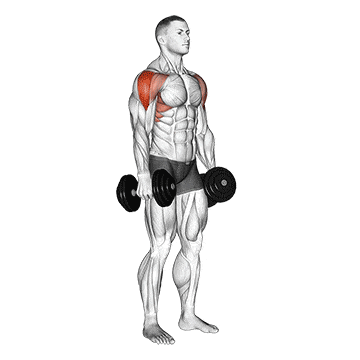
Best Variations Of Lateral Dumbbell Raise
The standard dumbbell lateral raise works well for the shoulders, but adding variations to your routine can help to improve your form, fix imbalances, prevent plateaus, or make your workout harder
Slightly altering hand position, angle, tempo, or balance challenges engage stabilizer muscles and shoulders from new angles.
1. Seated Dumbbell Lateral Raise
The primary advantage of performing lateral raises while seated is stability.
When you do it on the bench, you eliminate the ability to use leg drive or torso swing to help lift the weight. This forces your medial deltoids to do almost all the work.
It’s a great way to target the lateral deltoids while minimising the involvement of other muscle groups.
If standing and bracing cause strain to your lower back, the seated version offers more support.
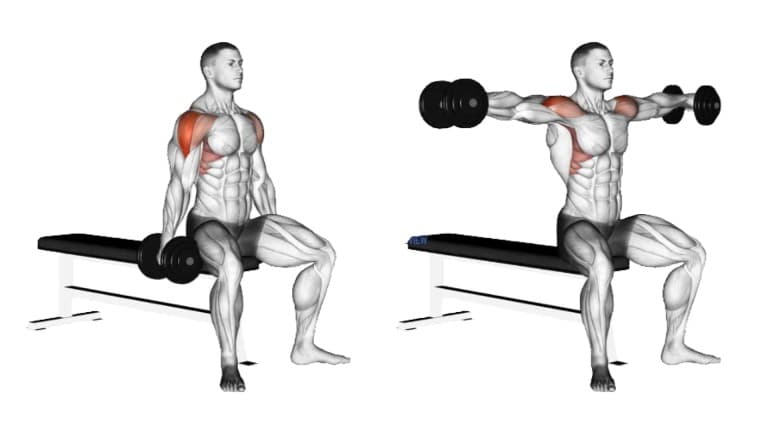
How To Do
- Sit upright on the edge of a flat bench. Don’t lean back against a backrest (unless specifically doing an incline variation).
- Hold the dumbbells at your sides with palms facing your body, just like the standing version.
- Slowly raise the dumbbells to the side.
- Raise the dumbbells until your upper arms are roughly parallel to the floor. Keep your hands slightly below or level with your elbows.
- Hold for a brief moment, and then slowly lower the dumbbells back down to the starting position.
2. Dumbbell Chest Supported Lateral Raises
When you support your chest against an incline bench, you make it virtually impossible to use momentum and reduce the involvement of other muscle groups. It forces pure shoulder abduction.
I often use this technique with clients who tend to swing the weight unconsciously, or as a great finishing move to safely isolate and burn out the shoulders.
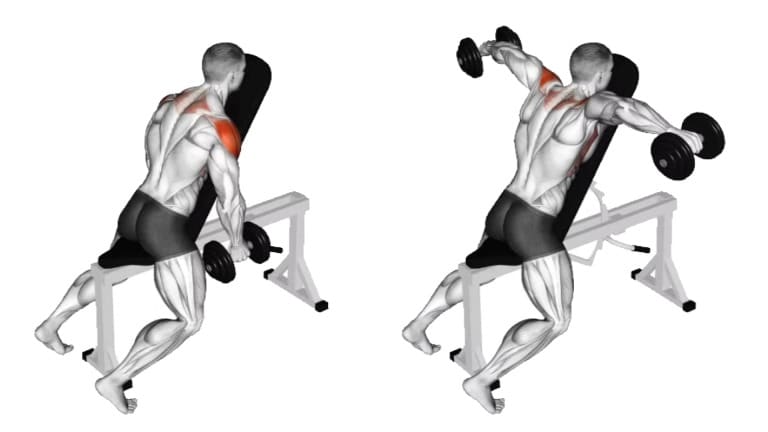
How To Do
- Set an incline bench to roughly 45–80 degrees. Experiment to find what feels best and targets the desired area (lower angle = more rear delt bias).
- Lie chest-down on the incline bench. Your chest and upper stomach should be firmly supported. Your head should be above the top of the bench.
- Let the dumbbells hang straight down towards the floor, palms typically facing each other (neutral grip) or slightly turned back.
- With your elbows slightly bent, raise the dumbbells out to your sides until they are at shoulder level.
- Hold for a second, then slowly lower the dumbbells back down to the starting position.
3. Dumbbell Lateral To Front Raise
The dumbbell front raise to lateral raise is an exercise that combines two exercises (front raise and lateral raise) that build and strengthen the middle deltoids and the anterior deltoids of the shoulders.
You raise the dumbbells out to the sides (lateral raise), then bring them forward to the front raise position without lowering them, before finally lowering them back down.
The transition phase itself requires significant shoulder control and stabilisation.
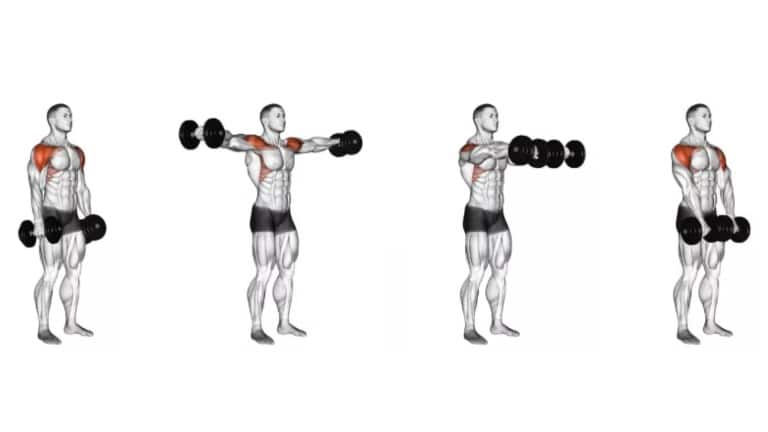
How To Do
- Stand tall, feet shoulder-width apart, knees slightly bent, core engaged. Hold a pair of dumbbells at your sides with your palms facing in.
- Do a standard dumbbell lateral raise. Raise your arms out to your sides in a wide arc.
- Stop when your upper arms are roughly parallel to the floor. Avoid shrugging.
- At the peak of the lateral raise (arms parallel), smoothly sweep your arms forward until the dumbbells are directly in front of your body, still at shoulder height (like the top position of a front raise).
- From the front raise position, slowly lower the dumbbells under control straight down towards the front of your thighs.
- Bring the dumbbells back to the starting position (sides of thighs) before initiating the next rep.
4. Dumbbell Full Can Lateral Raise
In a standard lateral raise, your palms often face down. In the Full Can, you actively maintain a degree of external rotation throughout the lift, leading with your thumb.
If standard lateral raises cause discomfort or a pinching sensation, the Full Can variation might feel significantly better and allow you to train the medial deltoid more comfortably.
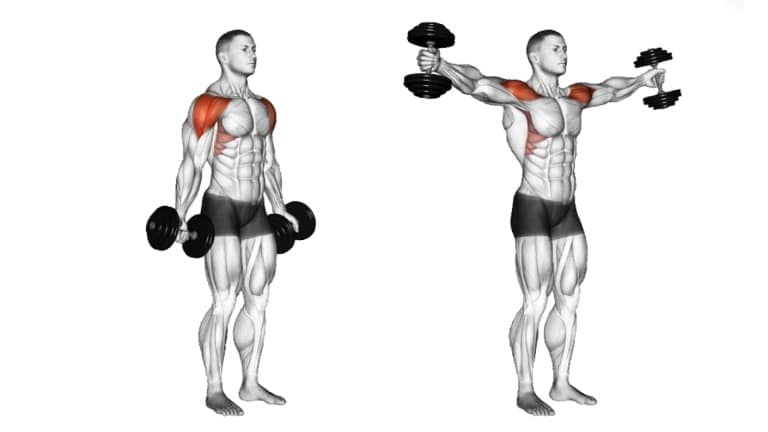
How To Do It
- Hold the dumbbells with your palms facing forward and your arms at your sides.
- Raise the weights out to your sides until they are parallel to the floor.
- Your hands should be positioned as if you were holding a can by the top of the can, hence the name “full can.”
- Pause momentarily, then slowly lower the dumbbells back to the starting position.
5. One Arm Dumbbell Lateral Raise
Most of us have a slightly stronger or more dominant side. Training unilaterally (single arm) immediately highlights these differences and allows you to work on bringing the weaker side up to par.
This is one of my favourite variations to refine technique, correct imbalances, and maximise focus on the medial deltoid
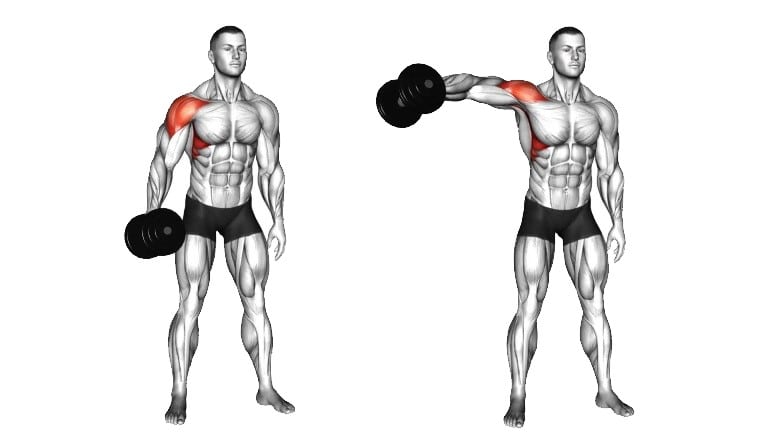
How To Do
- Stand tall with a dumbbell in one hand. Let the dumbbell hang at your side with a neutral grip (palm facing inward).
- Stand next to a stable support (rack, wall, bench). For stability, place your non-working hand on the support at roughly waist or chest height.
- Now bend your elbow and raise the dumbbell to your side. Lift until your arm is about parallel to the floor (shoulder height).
- Now, lower the dumbbell in a controlled manner back to the starting position.
- Perform all reps on one side and then repeat with the other arm.
6. Leaning Dumbbell Lateral Raise
In a standard lateral raise, the deltoid muscle doesn’t feel much tension when the dumbbell is hanging at your side. But when you lean a bit, gravity starts pulling the weight away from your body’s center right from the beginning, which means your medial deltoid is under tension from the very first inch of the movement.
It puts your lateral deltoid under tension through a greater portion of the range of motion.

How To Do
- Stand sideways next to a sturdy, fixed object you can hold onto firmly (e.g., an upright power rack, stable machine frame, pole, or even a doorway edge).
- Place your feet relatively close to the base of the support. Grasp the support with your inside hand around chest or waist height.
- Lean (30–60 degrees away from vertical) your entire body away from the support. Your inside arm is holding the support.
- Hold the dumbbell in your outside (working) hand. Let it hang straight down towards the floor.
- Raise the dumbbell until your working arm is roughly parallel to the floor. Depending on your lean, this might not be parallel to your torso.
- Briefly pause at the top, feeling the peak contraction in the medial delt.
- Now, lower the dumbbell in a controlled manner back to the starting position.
- Complete all reps on one side before carefully standing up, switching sides, and repeating.
7. Incline Dumbbell Side Lateral Raise.
If you’re looking for a way to get more creative with your dumbbell lateral raise, why not try an incline lateral raise?
Many of the movements that work the same muscle group may look alike, but they focus on different parts of the muscles because they are at different angles.
If you want to develop better muscle specifically, remember that including exercises focusing on different aspects of your training program is more beneficial.
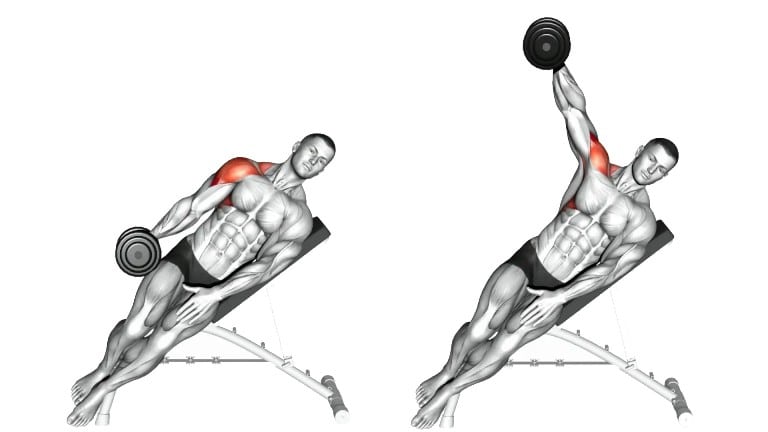
How To Do
- Lie sideways on an inclined bench, set at 55 degrees, with your armpit over the top of the bench.
- Hold the dumbbell so that it rests sideways on your upper thigh.
- Keeping a slight bend in your elbow, raise the dumbbell out from your side until your elbow is in line with your shoulder.
- Pause a moment at the top of the motion before slowly lowering the weights back down to the starting position.

Manish is a NASM-certified fitness and nutrition coach with over 10 years of experience in weight lifting and fat loss fitness coaching. He specializes in gym-based training and has a lot of knowledge about exercise, lifting technique, biomechanics, and more.
Through “Fit Life Regime,” he generously shares the insights he’s gained over a decade in the field. His goal is to equip others with the knowledge to start their own fitness journey.
